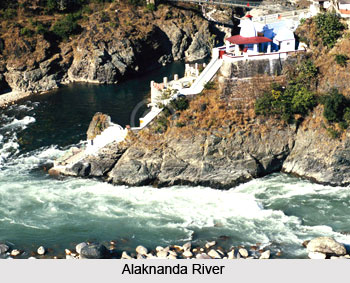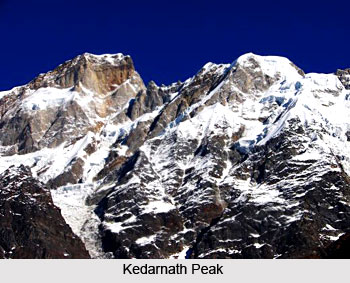 Geography of Rudraprayag District mainly includes mountainous terrains. The geology of the region shows that the Himalayas are the young mountains in the world. Most of the hilly section of the range in the district is deeply cut into by the headwaters of Alaknanda River. In some parts of the district uplift has been considerable since the mid-Pleistocene period, in others there are great stretches of high but subdued topography and elsewhere there are the deepest gorges. Physiographically, Rudraprayag District, which lies in a region of tectonic or folded and over thrust mountain chains, has strata and is structurally marked by complex folds, reverse faults, over thrusts and napes of great dimensions.
Geography of Rudraprayag District mainly includes mountainous terrains. The geology of the region shows that the Himalayas are the young mountains in the world. Most of the hilly section of the range in the district is deeply cut into by the headwaters of Alaknanda River. In some parts of the district uplift has been considerable since the mid-Pleistocene period, in others there are great stretches of high but subdued topography and elsewhere there are the deepest gorges. Physiographically, Rudraprayag District, which lies in a region of tectonic or folded and over thrust mountain chains, has strata and is structurally marked by complex folds, reverse faults, over thrusts and napes of great dimensions.
As the elevation of Rudraprayag District ranges from 800 metres to 8000 metres above see level its climate also varies largely depending on the altitude. The winter season is from about mid November to March. As most of the region is situated on the southern slops of the outer Himalayas, monsoon currents can enter through the valley, the rainfall being heaviest in the monsoon from June to September. During this period around 70 to 80 percent of the annual precipitation is accounted for in the southern half of the district and 55 to 65 percent in the northern half. The effectiveness of the rains is related to low temperature. However, the effectiveness is neither uniform nor even positive in areas where either the vegetation cover is poor and has steep slopes or the soils have been so denuded that their moisture absorption capacity has become marginal.
The details of temperature recorded at the meteorological observatories in Rudraprayag District show that the highest temperature recorded is 34 degree Celsius and lowest is zero degree. January is the coldest month after which the temperature begins to rise till June or July. Temperature varies with elevation. During the winter cold waves in the wake of western disturbances may cause temperature to fall appreciably. Snow accumulation in valleys is considerable. The relative humidity is high during monsoon season, generally exceeding 70 percent on the average. The driest part of the year is the pre monsoon period when the humidity may drop to 35 percent during the afternoon. During the winter months, humidity increases towards the afternoon at certain high stations. Skies are heavily clouded during the monsoon months and for short spells when the region is affected by the passage of western disturbances. During the rest of the year the skies are generally clear.
 Geography of Rudraprayag District comprises several major rivers and river systems. Mandakini River, which is the most important river coming down from the slopes of Kedarnath peak joins Alaknanda at Rudraprayag. The river actually originates from the springs fed by melting snow of Chorabari glacier about one km above Kedarnath temple. The fact is that the main rivers of the Himalaya are older than the mountains they traverse. All the rivers of the district are snow fed. As the water levels of the rivers are much below the arable land levels, the rivers cannot be generally used for irrigation purposes.
Geography of Rudraprayag District comprises several major rivers and river systems. Mandakini River, which is the most important river coming down from the slopes of Kedarnath peak joins Alaknanda at Rudraprayag. The river actually originates from the springs fed by melting snow of Chorabari glacier about one km above Kedarnath temple. The fact is that the main rivers of the Himalaya are older than the mountains they traverse. All the rivers of the district are snow fed. As the water levels of the rivers are much below the arable land levels, the rivers cannot be generally used for irrigation purposes.
Rudraprayag District is rich in flora and fauna. Moreover, in the warm valleys of the extreme southern part of Rudraprayag District, some species of the trees of the plains such as mango, jamun, Peepul, banyan and shisham up to an altitude of about 915 metres. In Alaknanda valley, the bases, slopes, gorges and tops of the hills up to the height of 1067 metres are well wooded with high trees such as catechu, bahera, har, amaltas, bel, kachnar and dhak. A large variety of creepers some of which have broad green leaves also thrive iin in the vicinity of the trees. Above an elevation of 3439 metres Moru or Tilonj and Kharasu grow and their timber is also used for manufacturing agricultural implements. The chief varieties of timber trees found in the groves of the district are pine, tun, deodar and many varieties of walnut. Many medicinal blooms, herbs and plants, greatly valued in Ayurveda grow in the district. Most of the flowers and plants come up during the rains but wither away from October to May, imparting the characteristic brown colour to the countryside during the winters.
Several important minerals are found in Rudraprayag District are found. Asbestos, Soapstone or Steatite, Copper, Iron, Graphite, Gypsum, Lead, Slate, Building Stone and Sulphur are the main minerals found here. Other minerals found in the district are Antimony, Arsenic, Lignite or Brown Marble, Mica and silver.






